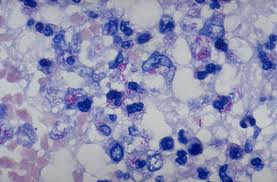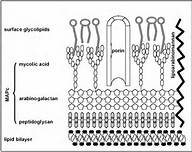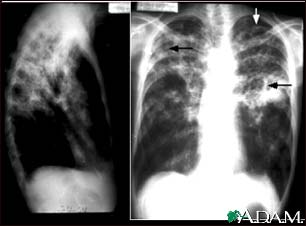Tuberculosis disease: Difference between revisions
From MicrobeWiki, the student-edited microbiology resource
| Line 26: | Line 26: | ||
==Pathogenesis== | ==Pathogenesis== | ||
===Transmission=== | ===Transmission=== | ||
===Infectious Dose, Incubation, and Colonization=== | ===Infectious Dose, Incubation, and Colonization=== | ||
Revision as of 09:53, 22 July 2013

Mycobacterium tuberculosis under microscope [1]
Etiology/Bacteriology

Mycobacterium tuberculosis Stain [2]
Taxonomy
Kingdom: Bacteria
Phylum: Actinobacteria
Class: Actinobacteria
Order: Actinomycetales
Family: Mycobacteriaceae
Genus: Mycobacterium
Species: tuberculosis
Description

Mycobacterium tuberculosis Stain [3]
Pathogenesis
Transmission
Infectious Dose, Incubation, and Colonization
Epidemiology
Virulence Factors
Clinical Features and Symptoms

Mycobacterium tuberculosis presented via X Ray [4]
Diagnosis
Treatment
Prevention
Host Immune Response
References
1 Conway, Tyrrell. “Genus conway”. “Microbe Wiki” 2013. Volume 1. p. 1-2.
2 NHS General Information on Tuberculosis
3 Ozimek, Maleana Mycobacterium tuberculosis
4 CDC General Information on Tuberculosis
5 PPD skin test Medline Plus
6 Exposure to Tuberculosis Vanderbilt Occupational Health Clinic
Created by Jennifer Gallup, student of Tyrrell Conway at the University of Oklahoma.
